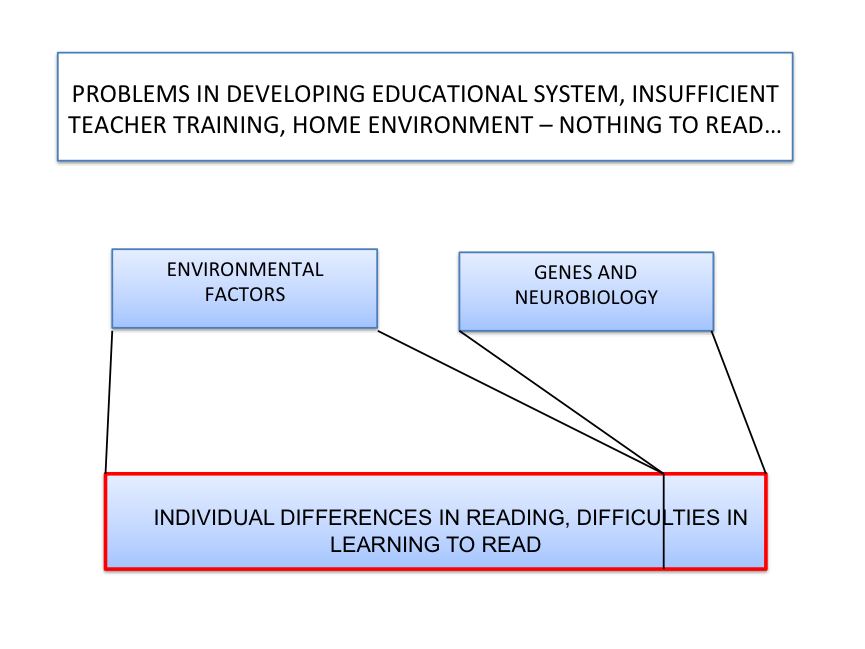eTale 2022
How our genes and neurobiological factors and environment affect learning to read?
Studies in behavior-genetics are based on similarities between large samples of identical and fraternal twins, that enables to separate genetic and environmental influences. Conclusion from many behavior-genetic twin studies to the question “Why do children differ in their reading and related skills?” – is that on average, after the first year of formal literacy instruction, they differ mostly because of the genetic differences between the children.
Yet, reading environment and instruction is important for reading development. If we strongly boost reading instruction (e.g. double the time and intensity) increase in average reading ability would be entirely due to this environmental change. However, individual differences in reading abilities after this boosting will mostly continue to be due to the genetic influences. In turn, this general conclusion is true only at the group level. In individual cases reasons for good or poor reading can be mainly environmental or genetic.
In principle, twin samples with greater reading related environmental variance are likely to show lower average estimates for genetic influences and higher average estimates for environmental influences on individual differences or deficits in reading. If we compare developed countries (with developed educational system, high quality of teacher training, plenty of reading material at home etc.) and developing countries (problems in educational system, low quality of teacher training, no reading materials at home etc.) we can find differences concerning the reasons behind reading difficulties. For example, if we select the poorest readers from the classrooms, the reasons behind reading difficulties can be very different in these countries as you see in following figures.


Cognitive
factors. The
most important cognitive functions in reading difficulties are
phonological processing, rapid automatized naming (rapid
and automatic retrieval of verbal material from the long-term memory
RAN) and
short-term and working memory.
We
all have a phonological processing system, which is used to process
basic word sounds. These basic word sounds are called phonemes. This
is what children tend to learn when they begin to practice decoding.
These phonemes are blended together to form spoken words. The
phonological processing system’s main role is to analyze and
manipulate sound structures of words. This means that you can hear
the sounds and syllables of the words and convert them into letters
(spelling). You can also see letters on a page and convert them into
something you can hear (reading). Many children with reading
difficulties struggle to either split words they hear into separate
sounds or combine sounds to syllables and words. Because of this they
are more likely to struggle with reading and spelling.
Many
children with reading difficulties are slower than their classmates
in naming quickly serially presented visual stimuli that are already
well known to them. This process is called “Rapid Automatized
Naming – RAN. The ability of the child to retrieve names of
letters, numbers, objects and colors from the long-term memory can
easily be assessed by using simple RAN-tasks. Naming speed seems to
be related to almost all aspects of reading, but most strongly to
reading fluency or speed.
The
concept of working memory (WM) evolved from the concept short-term
memory (STM). In the literature these concepts are sometimes used as
synonyms. Dr. Alan Baddeley uses STM to refer simple temporary
storage of information in contrast to WM, which implies the
combination of storage and manipulation WM as mental workspace.
(Links to Working-memory + power points)
Motivational
factors.